Report
Welcome to Bain & Company’s third annual Global Healthcare Private Equity Report, our review of the significant trends of the past year and a look at some of the most compelling prospects for private equity investors in the healthcare sector in 2014.
Healthcare continues to be an attractive area for private equity investment as the landscape evolves. Similar to 2012, several factors constrained mega-deal activity in healthcare, led by stiff competition from strategic buyers and rich valuations. Despite some dampening in investment activity, these trends had the welcome consequence of creating a robust exit environment. The number of portfolio company exits hit a 10-year high in 2013, with the majority going to strategic players and several making sizable IPOs.
When funds made large investments in 2013, they spread them fairly evenly across sectors, unlike the clustering of $1 billion-plus deals seen in the provider and services space in 2012. The biggest concentration of these large deals was in the pharma sector, including both traditional pharmaceutical assets and service organizations like contract outsource organizations (CXOs). The provider and services sector also remained strong around the globe and was especially popular in emerging markets such as India and Southeast Asia.
Investments generally fell under one of three themes, with the first two extending the trends set in motion in 2012: (1) prize assets in good markets with strong competitive positions and rich valuations; (2) value plays focused on targets with strong cash flows in mature businesses; and (3) earlier-stage assets in markets that are too new to offer big platform assets or clear favorites.
Looking ahead, we are optimistic that the pace of investment and exit activity will remain brisk. Private equity funds should continue to see attractive opportunities for investment in both earlier-stage and larger assets. That said, it is getting harder to win in healthcare private equity given the rising level of competition within the private equity sector and from strategic investors. It is an open question as to whether we will see a bifurcation in fund strategy, with some funds investing simply to stay in the game long term and willingly accepting lower returns in their target investment segments while others go “heavier” into healthcare and take on more regulatory, reimbursement or technology risks with the hope of higher returns. Regardless of their approach, being smart about their investment strategy, staying focused on their deal sweet spot and growing the value of their portfolio companies will give firms an edge.
Healthcare private equity market 2013: The year in review
Section highlights
- Global healthcare buyout deal value declined despite a small increase in the number of deals due in part to activity in smaller, earlier-stage deals
- Funds spread investments across many sectors, with few concentrations of deals
- Carve-outs from strategic players fueled some of the largest deals
Across all industries, the disclosed value of global buyout deals in 2013 was up 22% over 2012, despite an 11% decline in the number of deals, largely the result of two mega-deals worth more than $20 billion each (Dell and Heinz). Healthcare, however, saw the reverse trend: There were no mega-deals in 2013 and buyout deal value was down 23% despite a small increase in deal count, thanks to a heavy concentration of earlier-stage and middle-market deal activity (see Figure 1). In fact, of the top 10 global buyouts in 2013, there were no healthcare deals. All told, the value of healthcare buyout deals totaled slightly more than $16 billion in 2013, accounting for approximately 7% of all buyout deals globally, down from a peak of 16% in 2011.
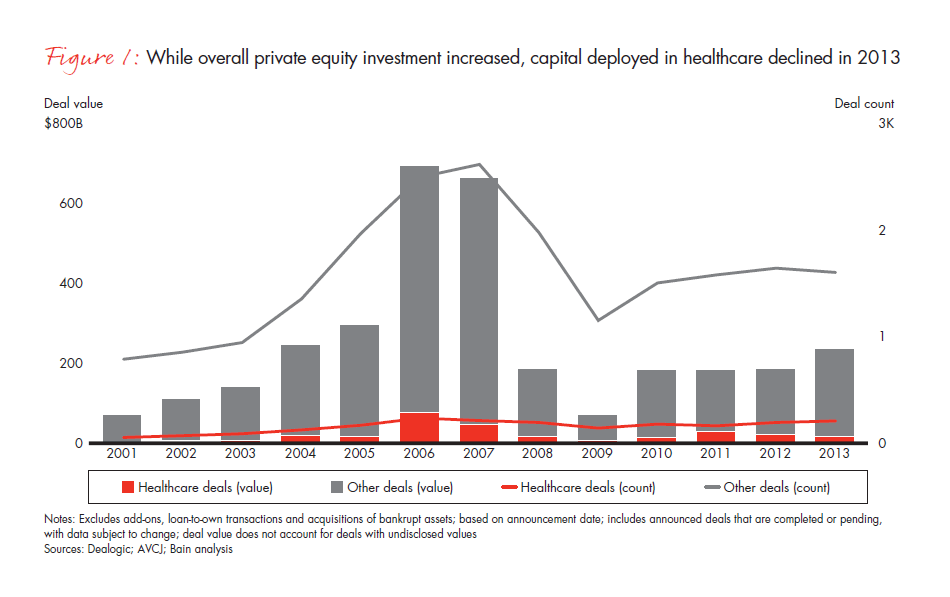
As we discuss later in this report, strategic competition was especially strong in the healthcare industry, particularly for middle-market and large assets. While strategic M&A deal value was up by 11% across all industries on a 14% decline in the number of deals, strategic M&A deal value in the healthcare industry was up a whopping 30% on a 7% decline in deals.
Overall, 209 healthcare buyouts were announced during the course of the year, with many of the largest ones in the fourth quarter. The combined value of the top 10 deals was approximately $11.5 billion in 2013 (see Figure 2), down from $12.6 billion in 2012. This value reflects the continued shift toward smaller transactions and stands in stark contrast to 2011, a year characterized by mega-deal activity, when the top 10 deals totaled almost $25 billion. (Notably, timing was a factor in the tally for 2013: If Johnson & Johnson’s [J&J] $4.15 billion sale of its Ortho Clinical Diagnostics [OCD] unit to The Carlyle Group had been announced before year-end, the picture would have looked quite different.) As we discuss later in the report, activity at the sector level reshuffled from 2012; while provider and services led by the number of deals, biopharma and services led in deal value and contributed five of the top 10 deals of the year.
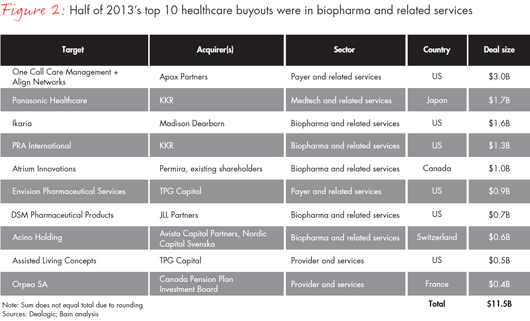
By and large, 2013 investments were scattered broadly, with little concentration. However, a few subsectors did see large enough clusters of deals to merit mention. Within pharma, private equity investors showed a healthy appetite for both traditional pharma assets and CXOs. Animal health, representing an alternative way to engage in the sector, was also an area of high interest, especially in Europe. In the provider and services sector, behavioral health was popular in the US, fueled by regulatory changes. Assets related to next-generation care models were also popular, playing on the transition from fee-for-service to value-based reimbursement and accountable care in the US. Specialty pharmacy/home infusion and home care assets were also popular in both the US and Europe as a way to ride cost-containment trends. In the payer space, workers’ compensation services assets maintained their popularity from 2012. Altogether, more than two-thirds of deals occurred outside of these top subsectors, indicating the wide dispersal of last year’s investment activity.
In their search for returns in 2013, investors were increasingly willing to invest in earlier-stage assets. In some areas, such as the emerging accountable care services space, early stage is the only way to enter. In others, such as pharma companies with pipeline risk, earlier-stage assets hold the most promise for much-needed growth. Notably, one approach growing in popularity is for sellers to package earlier-stage assets together with more mature assets in order to make the development risk more manageable. That increasing risk tolerance is underscored by the results of a recent survey of Healthcare Private Equity Association (HCPEA) members, in which funds report sizable increases in their interest in earlier-stage growth deals (see Figure 3). This heralds more down-market movement by large funds, and more competition for earlier-stage assets all around.
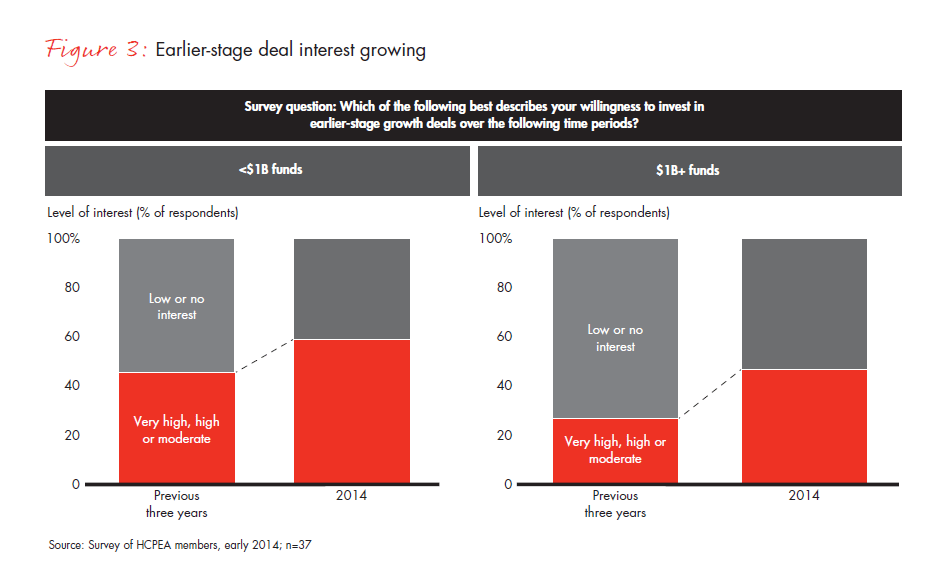
Some of the larger deals that happened in 2013 were the result of carve-out activity, as strategic players divested noncore assets. Panasonic and AmerisourceBergen sold large business units to private equity firms in 2013, and J&J announced the sale of OCD to Carlyle in early 2014. In addition, McKesson, GE Healthcare and United BioSource all carved out healthcare information technology assets that were scooped up by private equity buyers.
Private equity firms also continued to buy and build in order to create some scale in their portfolios, often by buying one or two large assets as a platform on which to acquire other smaller assets. For example, this occurred within the pharma contract research organization (CRO) space, where KKR bought and merged PRA International (PRA) and ReSearch Pharmaceutical Services (RPS), after which the combined entity bought patient studies firm CRI Lifetree. Likewise, this played out in the payer services space as Apax Partners simultaneously acquired and combined workers’ compensation services firms One Call Care Management (OCCM) and Align Networks. In similar fashion within the provider sector, Welsh, Carson, Anderson & Stowe (WCAS) in 2012 formed physician services organization U.S. Anesthesia Partners, which then bought Lake Travis Anesthesiology in 2013 as part of its build strategy and continued its expansion into 2014, adding Pinnacle Anesthesia in Dallas and JLR Medical Group in Orlando to the platform. Waud Capital saw the fruits of its buy-and-build strategy in 2013 when the firm exited CarePoint Partners, a specialty pharmacy provider built through 16 acquisitions and organic growth, via a sale to BioScrip.
Geographic trends
Global
Section highlights
- Large deals were mainly clustered in North America and Europe
- Asia-Pacific and the rest of the world continued to drive growth in deal count
- Provider and services was the most active sector in all regions
North America and Europe continue to lead investment activity within healthcare private equity, with North American targets accounting for seven out of the top 10 deals in 2013. However, growth in activity in Asia-Pacific and the rest of the world outpaced these regions (see Figure 4). While the number of buyout deals grew at a compound annual rate of 5% in North America and 3% in Europe over the last five years, it has grown by more than 45% in the Asia-Pacific region and the rest of the world. Asia-Pacific also saw a rare billion-dollar deal via Panasonic’s carve-out of 80% of its healthcare business. The top 10 deal list followed historical patterns, with the majority of deals occurring in the US and Europe; however, in 2013 there was some geographic diversity by way of deals in Japan and Canada. By sector, provider and services was the most active across all of the regions, while medtech shrank a bit in each of the regions compared with 2012 (see Figure 5).
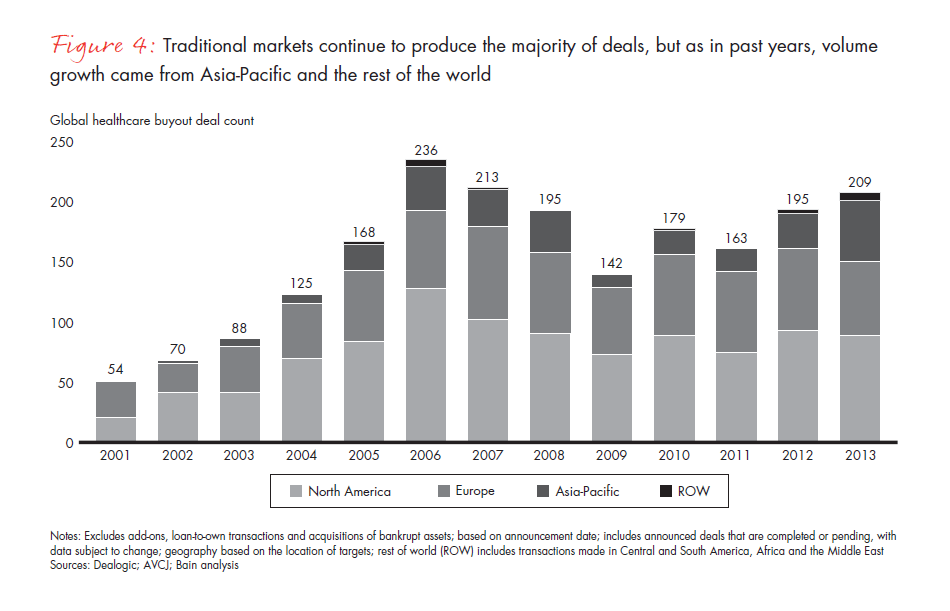
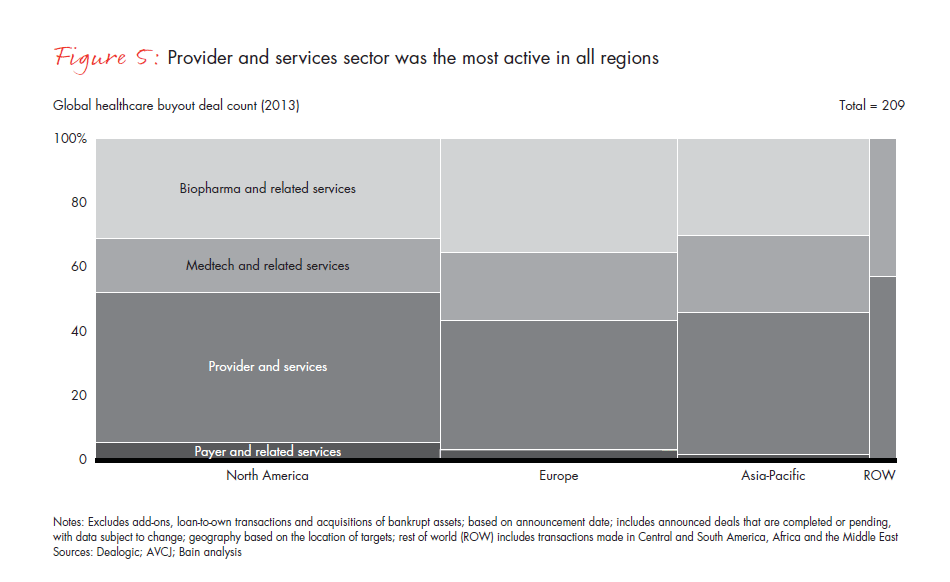
North America
Section highlights
- Uncertainty surrounding US healthcare reform persisted
- Capital continued to flow toward assets with a cost-containment angle
- Robust equity markets made purchases harder but opened up an exit window
- Services assets in a few key niches drove significant interest
Macro environment
Implementation of US healthcare reform dominated the headlines in North America’s biggest market in 2013. The political squabbles it has generated, along with legislative battles such as state-by-state Medicaid decisions, added a new layer of uncertainty to the healthcare marketplace. That contributed to a decrease in overall deal value in 2013 and a shift in the sector mix. While the busiest sector by number of deals was provider and services, the value of deals in this sector was a fraction of 2012 levels. In contrast, investments in the payer space increased both in value (led by Apax’s $3 billion OCCM/Align deal) and in the number of deals (driven in part by more pure-play healthcare payer assets coming to market than in previous years).
A very robust US stock market in 2013 had several implications for private equity activity. Potentially to the detriment of private equity bidders, some attractive assets were able to take the IPO route instead of coming up for sale and rich public valuations made assets that were for sale more expensive. On the brighter side, strong public equity markets were a boon for private equity funds seeking to exit investments, as we discuss later in the report.
Sectors and themes
Despite the uncertainty caused by the regulatory environment, the twin pressures of containing costs and improving outcomes remain central to the US healthcare system and, accordingly, remain central to many private equity investment themes. One major trend within the healthcare system, for example, is that providers are starting to reorganize themselves to coordinate patient care more efficiently. One example of how fast this is occurring: The number of accountable care organizations (ACOs), including those approved by the Centers for Medicare and Medicaid Services (CMS) and those focused on commercial populations, more than doubled between June 2012 and June 2013 and stood at approximately 600, covering 18 million lives as of January 2014, according to research firm Leavitt Partners.
While private equity funds are not directly involved in ACOs, they are investing in new segments emerging to serve them, such as services and tools aimed at improving provider workflows and patient outcomes. Investments span a variety of provider and services assets, including healthcare-related information technology (HCIT) solutions, consulting services for providers and even new provider care models. Within the HCIT space, investments included WCAS’ acquisition of GetWellNetwork, aimed at improving patient engagement and satisfaction; Bain Capital Ventures and Spectrum Equity’s minority investments in MedHOK, a cloud-based software-as-a-service platform that helps providers capture patient outcome data; and Summit Partners’ stake investment in COMS Interactive, which offers solutions for improving resident health in skilled nursing facilities. On the consulting side, Geisinger Health System and Oak Investment Partners partnered to launch startup xG Health Solutions, which offers products and services based on Geisinger’s experiences delivering cost-effective, high-quality patient outcomes. Combining consulting with an HCIT solution, Evolent Health received funding from existing investors, The Advisory Board Company and UPMC Health Plan, as well as new investor TPG Growth. Within the realm of new provider care models, EDG Partners, in partnership with the Nashville Capital Network, invested in Unity Physician Partners, a physician group that offers co-located primary care and behavioral health to better integrate physical and mental healthcare treatment. It is no surprise that many of these investments were small and that many of these assets are earlier stage, as larger assets do not yet exist in these emerging niches.
Another sector that generated a great deal of interest was behavioral health. The interest was supported both by legislation—including US mental health parity legislation in 2008 and the more recent Affordable Care Act’s expansion of Medicaid and coverage for substance abuse and behavioral health services—and by past private equity successes in the space, such as Waud Capital–backed Acadia Healthcare, which has delivered continued growth and strong stock market performance. Investments in 2013 included Trinity Hunt Partners’ majority stake in potential platform asset Lakeview Health Systems LLC, a substance abuse treatment company, which marked the firm’s third investment in the behavioral health sector. Building on Kinderhook Industries’ initial 2011 investment, Mansa Capital and Kinderhook provided additional funding to E4 Health, which provides employee assistance programs and behavioral health risk management programs. In addition to investment activity, 2013 saw organic growth in existing private equity-backed platforms, such as the construction and opening of new behavioral health hospitals within WCAS’ Springstone platform.
Cost-containment trends fueled an uptick in deals involving outsourced services. In the pharma and medtech sectors, this translated into strong interest in CXOs. In the provider and services space, Clayton Dubilier & Rice (CD&R) took a stake in a sterile compounding outsourcer for hospital pharmacies, PharMEDium Services, in a deal that reportedly valued the company at approximately $1 billion. Home care and home infusion were also popular, as they offer lower-cost care sites. As discussed throughout this report, this trend played out globally, not just in the US.
We expect many of these trends to continue to influence investment activity. One additional area that is capturing interest in the US is hospitals. Currently, strategic players dominate this space, as detailed later in the report, but private equity investors are increasingly attracted by the clear operational inefficiencies that hospitals present, along with the potential for rapid consolidation and business model evolutions necessitated by the changing payment landscape. That said, funds recognize the significant risks in investing in fee-for-service, facility-based assets, meaning future investment activity may be spotty.
Who is investing
Big private equity players including Apax Partners, KKR, CD&R and Madison Dearborn Partners led the large healthcare deals in North America in 2013. The middle market continued to see fierce competition between traditional middle-market players and larger funds looking to put capital to work despite the dearth of mega-deals.
While US deals dominated North America, investments on the continent outside of the US continued, including European investor Permira taking a controlling stake in Canada-based dietary supplement maker Atrium Innovations in a deal that valued the company at approximately $1 billion. There were few healthcare deals among Canadian private equity players; examples of activity that did occur include Canada Pension Plan Investment Board’s approximately $440 million minority investment in Orpea SA, a European provider of long-term care services, and a variety of acquisitions made by OMERS-backed portfolio companies.
Europe
Section highlights
- Deal activity was slow due to relatively few sizable assets coming to market
- Investors were still wary of reimbursement risk
- Many GPs were focused on fixing current assets in the “year of the portfolio”
Macro environment
Overall, 2013’s deal count in Europe was down only slightly from that in 2012, but deal value was much lower than in the previous year, when three $1 billion-plus deals buoyed the numbers.
The main causes of the sluggish pace were trends that have been playing out for several years. The sizable assets in Northern and Western Europe rarely come up for sale, and when they do, the valuations are high and competition from strategic players fierce. The economies of Southern Europe have yet to recover from the 2008 financial crisis. And in Central and Eastern Europe, regulatory volatility, combined with a lack of sizable assets, has thwarted deal activity despite continued interest. The global investment environment is also contributing to the scarcity. With few other attractive investment opportunities, the family funds that hold many healthcare assets in Europe have little incentive to sell their existing assets.
Healthcare reforms continued across the continent in 2013. Their impact ranged from structural changes focused on improving overall performance to new and intensified cost-containment and cost-sharing measures. In England, reforms primarily impacted the provider sector: They abolished primary care trusts, shifted power to Clinical Commissioning Groups and encouraged more competition for National Health Service (NHS) contracts. In France, biopharma companies were impacted as the government implemented a regulation that introduced formal medico-economic assessments into the approval and pricing decisions of drugs and continued discussions on another regulation that would shift pricing and reimbursement decisions for drugs to be based solely on comparisons with existing treatments (instead of on clinical value and therapeutic improvement). After major regulatory changes in previous years, German reforms focused on patient rights, instituting a new “treatment contract” that governs the patient-provider relationship. Across Europe, new regulations impacting medical device manufacturers took a major step toward implementation, but the impact will be less severe than originally expected since a controversial, centralized system of premarket approval for select devices that could have increased costs for manufacturers and potentially delayed patient access to new technologies was amended at the last minute. However, some level of uncertainty will persist until lawmakers reach an agreement on the final wording of the regulations.
Despite the slow deal environment, firms active in Europe kept busy behind the scenes by investing in post-close work to maximize the value of assets they already own. This “year of the portfolio” was a logical corollary to the fact that a number of European investments over the last few years have involved “hairy” assets that required significant changes in both management and operations to generate returns.
Sectors and themes
Investment levels in the medtech and provider sectors in Europe were down in 2013 compared with 2012, when these sectors saw three $1 billion-plus deals between them. Deal value in the provider sector was especially slow, coming in at only a third of the level seen in 2012, partially due to the dearth of large deals like the previous year’s Mediq (a pharmacy distributor) and Four Seasons (nursing homes) deals. As last year’s Global Healthcare Private Equity Report explored, investors are hesitant about the exposure to reimbursement risk that can come with this sector (see below, “Articulating reimbursement risk: ‘Healthcare heavy’ vs. ‘healthcare light’”). While 2013 provider deals involved a variety of exposures to reimbursement risk, the largest deals were in the retail dental clinic space, which involves minimal exposure as payments are mainly from private payers. There were also some deals in areas with moderate exposure to reimbursement risk, such as home care and home infusion. For example, Midi Capital SAS invested in home health provider France Perfusion. Activity in areas with significant exposure to reimbursement risk was more limited and generally occurred via hospital deals, such as Dinamia Capital Privado’s additional investment in Hospital de Benalmadena Xanit SL. Meanwhile, the medtech sector—which in 2012 claimed the $2 billion-plus BSN Medical deal—predominantly saw stake investments in smaller assets in 2013.
Investment levels in the biopharma sector in Europe were more robust than in other sectors, relatively speaking, with deals spread across a variety of subsectors including generics, animal health, traditional pharma, biotechnology and services. In one of the larger deals of the year, UK-based Charterhouse Development Capital made its first foray into Italy with a $424 million investment in Doc Generici Srl, a drug maker with more than 15% of the Italian generics market. Another relatively large deal was Bain Capital’s $349 million majority investment in Plasma Resources UK. Owned by the British government, Plasma Resources UK is the Department of Health’s blood plasma supplier and was in search of a private sector partner to fund necessary modernization. On the strategic side, BC Partners portfolio company Aenova Group, acquired in 2012, followed through on plans to grow via M&A by purchasing Haupt Pharma in 2013 after its acquisitions of Temmler Group and Euro Vital Pharma at the end of 2012. Given the availability of assets and level of excess manufacturing capacity, we expect this type of consolidation within the biopharma sector to continue with significant private equity interest.
Who is investing
Both global and European funds were active in Europe in 2013. In response to the tough deal environment over the last few years, it is no surprise that European funds have been deepening their healthcare expertise to be better prepared to bid on prize assets, make contrarian plays and digest the complex corporate carve-outs that may come their way. This trend, which started with the largest funds, is now trickling down to middle-market funds. In addition, European funds are looking at newer geographies, including Asia-Pacific, especially in the context of portfolio value-creation activities.
Asia-Pacific
Section highlights
- Record deal value and volume tallied for the year
- India and China continued to lead deal activity, with a few large deals in more mature markets
- Provider deals dominated activity
Macro environment
Asia-Pacific saw record deal value and volume in 2013, as private equity investors injected $3.2 billion into 50 buyout deals in the region, up from $2.6 billion and 29 buyout deals the year before. Most activity was in India and China, with a few large deals in the more mature Asia-Pacific markets (Japan and Australia). In India and China, healthcare was a bright spot for private equity investors, with growth in the number of investments in both of these markets outpacing most other industries despite regulatory uncertainty in both countries and concerns around a depreciating rupee in India. Investors continue to see opportunity for the private sector to help address the many unmet healthcare needs in these countries, which today have insufficient infrastructure to support aging populations, rising incidences of disease and a general need for more affordable healthcare. A significant number of investments occurred beyond the $3.2 billion buyout value, as well, since the majority of private equity investments in emerging Asia-Pacific markets continue to be in the form of minority growth equity investments rather than buyouts. Investors also took part in 18 healthcare private investments in public equity (PIPE) deals in Asia-Pacific worth slightly more than $500 million in 2013.
Sectors and themes
China and India were the growth engines in terms of deal count, claiming 54% of total buyout deal volume in the region, although the largest deals occurred in the more developed Asia-Pacific markets, which lend themselves better to large scale buyouts. Transactions in Japan, South Korea and Australia comprised $2.2 billion out of the $3.2 billion regional total in 2013. While large healthcare transactions in these markets are sporadic, global carve-outs by multinationals were a particular catalyst for deals last year. KKR’s $1.7 billion investment in Panasonic Healthcare in Japan was a notable example, with Archer Capital’s $279 million acquisition of Lend Lease Group’s aged care unit in Australia following the same trend. Looking ahead, private equity funds are likely to continue to buy opportunistically in these markets as assets come up for sale.
Private equity funds invested across all major healthcare sectors, but the provider sector was by far the most popular, accounting for 22 of the 50 deals in Asia-Pacific last year. In India, the provider sector continued to enjoy the momentum it has seen in recent years and received a shot in the arm from success stories such as Apax’s 2013 exit from Apollo Hospitals with a reported 3.3 times return on its 2007 investment. (Notably, many of the exits in India for buyouts and minority investments continued to be in the form of secondaries.) Investors in India not only were active in tertiary care, but also moved into primary and specialty care (e.g., oncology, dental/vision and maternity/pediatric) and support services (e.g., diagnostics labs). Some of the most notable deals include Carlyle affiliate Anant Investments’ $156 million investment in the owner and operator of Indian hospital Medanta–The Medicity; Temasek’s approximately $26 million investment in HealthCare Global Enterprises, an operator of oncology-focused treatment centers; and TA Associates’ additional investment in the diagnostic laboratory chain Dr. Lal Pathlabs.
Unlike prior years, investors started to take a more serious look at the provider space in China, in part due to a strong government push to increase the role of the private sector in care delivery. Until now, investors have focused more on standalone type delivery segments (e.g., health checkup, dental/vision and maternity) and most are waiting to see how regulations evolve before they take on larger scale projects such as the privatization of public hospitals. However, the Chinese government is encouraging such investments in a number of ways, including setting a goal of having 20% of hospital beds in the private sector by 2015 (up from less than 10% in early 2013) and removing restrictions on foreign ownership. Some of the notable deals of the year include sovereign wealth fund GIC and Goldman Sachs’ $100 million investment in the checkup chain iKang Goubin; Carlyle, Cathay Capital Private Equity and China Ping An Insurance’s $49 million investment in the checkup chain Meinian Onehealth Healthcare; and Warburg Pincus’ undisclosed investment in the maternity-focused Amcare hospital chain.
Private equity investors were not unique in their interest in the provider segment. Strategic buyer Bupa, an international healthcare group with insurance and provider businesses, acquired Quality HealthCare Medical Services, the largest private clinic network in Hong Kong, from Fortis Healthcare for $355 million.
Provider deals in Southeast Asia continued to prove tricky, despite significant interest in that region. High valuation expectations are one limitation on deal count, along with structural issues such as a shortage of physicians and nursing staff relative to the expected demand for healthcare in coming years. As some of these factors resolve and entrepreneurs develop creative models to overcome these challenges, deal activity in the region is likely to pick up.
One theme that is starting to emerge in India and China is the move toward increased care integration, in which primary care providers play the gatekeeper role and help coordinate patients’ specialist services with the aim of finding both health and cost synergies. The opportunity to shape the healthcare provision landscape in these markets is on the agenda of many private equity investors in the region, and we expect this trend to play out over many years.
Deal activity in other sectors was relatively muted across the region in 2013. Investor interest in the medtech sector was strong, especially in light of recent handsome medtech private equity exits including Medtronic Corporation’s acquisition of China Kanghui in 2012 and Stryker Corporation’s acquisition of Trauson Holdings in early 2013; however, firms continue to struggle with very high valuation expectations and a shortage of scale assets. One new dimension in 2013 was that interest expanded from China—which typically leads medtech activity since the number of manufacturers in China significantly outnumbers those in other parts of Asia—to India, thanks to TPG Capital’s investment in surgical products manufacturer Sutures India. From a strategic perspective, Chinese medtech companies continued to look for opportunities to expand internationally in 2013, with MicroPort’s acquisition of Wright Medical’s US-based OrthoRecon business a notable example.
Biopharma deal count was up slightly in 2013, though deal values were down significantly compared with 2012. Several factors drove this trend, including the three large 2012 biopharma deals (Luye Pharma, 3SBio and Shaanxi BiCon) that absorbed much of the available capital for the region. In addition, increasing regulatory uncertainty and government pressure on drug pricing caused concerns around the viability of current business models in both China and India. Despite the concerns, however, interest in specialty pharma in India was especially strong and included services firms like contract manufacturing organizations (CMOs) and drugmakers aiming to sell into developed markets. The two most notable deals involved CMOs in India: KKR took an approximately $200 million stake in Gland Pharma, and Actis invested $48 million in Symbiotec Pharmalab.
Who is investing
The mix of buyers in 2013 looked very similar to the mix highlighted in last year’s Global Healthcare Private Equity Report. Consistent with the overall private equity market in China, there was significant activity from locally domiciled funds and limited activity from Western funds. Deals in China continued to be relatively small, with only one deal—the buyout of Simcere Pharmaceutical Group by a consortium including Hony Capital and current management—topping $100 million.
In India, multinational private equity firms including KKR and Carlyle continued to lead the largest deals. However, local funds are increasing their participation in India, as is evident from Multiples Alternate Asset Management’s investment in the hospital chain Vikram Hospital and IDFC Alternatives’ investment in the third-party administrator Medi Assist India.
Sovereign wealth funds continued to play an active role in the region, with Temasek investing in provider assets in India and China (oncology provider HealthCare Global and Phoenix Healthcare Group, respectively) and GIC investing with Goldman Sachs in China’s iKang Goubin, as we mentioned earlier.
Sector trends
Provider and services
Section highlights
- “Healthcare light” deals still drove value, but interest in ”healthcare heavy” increased
- Deals spanned a variety of subsectors, including elderly care, home care, retail health, provider services organizations and HCIT
In the provider space, private equity funds continued to explore deals with varying degrees of reimbursement risk—including “healthcare light” deals, or those that are more insulated from reimbursement risk, and “healthcare heavy” ones that include direct reimbursement risk (see below, “Articulating reimbursement risk: ‘Healthcare heavy’ vs. ‘healthcare light’”). In 2013, the balance between these types of deals further shifted toward healthcare heavy, thanks to high valuation expectations and few available assets in the healthcare light arena. Funds are increasingly recognizing that heightened reimbursement risk may be necessary for higher returns. This trend toward more difficult and often smaller deals drove down overall provider transaction value dramatically compared with 2012 (see Figure 6).
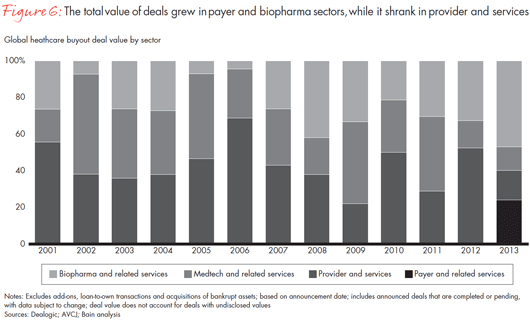
Healthcare light assets drove some of the larger deals in this sector in 2013 and spanned a variety of segments, including retail health (predominantly in Europe), HCIT, elderly care facilities and provider services. Two of the largest provider deals of the year, TPG Capital’s acquisition of Assisted Living Concepts in a deal valued at $450 million and Bridgepoint Advisers’ acquisition of UK dental care provider Oasis Healthcare in a deal valued at $280 million, were both healthcare light deals. Apax’s acquisition of OCCM/Align, discussed later in the payer and related services section, also shares similarities with these healthcare light provider assets, given the dispersion of reimbursement risk across state-level regulations. (Note: As discussed in “Articulating reimbursement risk: ‘Healthcare heavy’ vs. ‘healthcare light,’” elderly care facilities are an example of an asset type whose healthcare heavy vs. light classification depends on the unique circumstances of the asset. In the US, most skilled nursing facilities receive a significant portion of their revenues under CMS reimbursement, making them healthcare heavy, while assisted living facilities are typically private pay, making them healthcare light.)
Healthcare heavy investments also spanned a variety of segments. Similar to 2012, there were a number of hospital deals, predominantly in Europe and Asia-Pacific (though it is important to note that the reimbursement risk associated with hospital investments varies by the domestic payer environment). In the US and Europe, many deals involved specialty pharmacy/infusion and home care assets. Specialty pharmacy/infusion assets capitalize on two trends: the growth of specialty pharma drugs within biopharma pipelines and the continued shift toward lower-cost drug administration sites. There was also significant strategic interest in this area, as CVS Caremark acquired Coram late in the year for $2.1 billion and BioScrip acquired CarePoint Partners for $223 million in cash. In the US, other popular healthcare heavy segments included behavioral health and ACO services, which is classified as healthcare heavy due to the segment’s link to CMS’ ACO programs.
Another healthcare heavy area that saw a swell of M&A interest in 2013 was physician organizations. Private equity activity was tempered, however, as strategic players drove most deals. Mednax acquired several anesthesiology and neonatology groups, for one, while IPC acquired several hospitalist practices. Among the few notable private equity deals in this space were TPG Growth’s investment in an anesthesiology management company, NorthStar Anesthesia, and WCAS portfolio company U.S. Anesthesia Partners’ 2013 and early 2014 investments, discussed previously in the report.
Payer and related services
Section highlights
- Both deal volume and value were up
- Strong interest in workers’ compensation, brokers and various group health management firms
The payer and related services sector continued to be an area of interest to private equity investors in 2013, thanks to the ongoing focus on cost-containment trends both in workers’ compensation and group health. Compared with 2012, when the payer assets that came to market were mostly part of larger non-healthcare businesses, 2013 saw eight pure-play healthcare payer deals worth approximately $4 billion.
Apax Partners drove much of this value with its simultaneous purchases of OCCM and Align for a combined $3 billion. These two assets focus on the four largest nondrug specialty cost components for workers’ compensation payers: radiology, home health and durable medical equipment (OCCM) and physical/occupational therapy (Align). The combination will be the only asset in the industry with a full-service cost-containment offering across all nondrug specialty categories. In general, workers’ compensation fits well with an investor’s playbook: It’s a stable underlying market with diverse reimbursement risk (state-level vs. Medicare in group health), where the penetration potential of services can lead to significant growth. There was also activity on the brokers’ side of workers’ compensation, with Hellman & Friedman’s $4.4 billion buyout of multiline insurance broker Hub International.
Other payer deals covered a number of group health subsectors, such as pharmacy benefits managers (e.g., TPG Capital’s investment in Envision Pharmaceutical Services) and third-party administrators (e.g., FTV Capital’s stake in Empyrean Benefit Solutions). Notably, several deals involved assets outside the US. IDFC Alternatives took a stake in Medi Assist India, a third-party administrator; Palatine Private Equity took a stake in UK-based private medical insurance provider Chase Templeton; and BlackFin Capital Partners bought several French online health insurance comparison tools.
In the US, investors have yet to figure out how to capitalize on the new public exchanges, given the significant uncertainty around their near-term prospects for growth. Strategic interest so far has largely focused on private exchanges. However, the exchange services sector is one that we would expect to attract meaningful private equity investment in the near future as healthcare reforms mature and both public and private insurance exchanges grow in popularity. In addition, mirroring workers’ compensation, we expect to see continued interest in specialty benefits management in the group health space.
Biopharma and related services
Section highlights
- Half of the top 10 deals in 2013 were in biopharma and related services
- Services firms—particularly outsourcers—continued to be popular
- Animal health emerged as a sector of interest
- Private equity firms showed more tolerance for pipeline risk
The biopharma space remained very active in 2013, representing 33% of total deal count and a whopping 47% of deal value. As those numbers suggest, biopharma saw the lion’s share of large buyouts for the year, contributing five of the top 10 healthcare private equity deals. Both in those and in smaller deals, many investment themes persisted from previous years.
As in past years, services firms, especially CXOs, were popular with investors. This trend was influenced by two factors: Services firms are one step removed from reimbursement risk and (aside from CMOs) are able to grow without significant accumulations of physical assets. Also fueling this trend was the opportunity for continued consolidation. As previously mentioned, KKR was particularly active in the CXO space, creating one of the world’s largest contract research organizations via the combination of PRA and RPS, as well as investing in injectable drug manufacturer Gland Pharma. In the contract packaging niche, a consortium led by Frazier Healthcare bought AndersonBrecon for $308 million from AmerisourceBergen, and NBGI Private Equity acquired Stiplastics, a specialist manufacturer for the pharmaceutical industry. 2013 also saw some exits by private equity firms from CXO investments. For example, Kester Capital sold its interest in Chiltern International as the CRO consolidated its investor base under existing shareholders.
On the product side, there were investments across generic, pharma and biotech assets. For example, as previously mentioned, Charterhouse Development Capital acquired generics maker Doc Generici Srl for $424 million. Commercialized pharma assets continued to be popular, including Madison Dearborn’s $1.6 billion investment in Ikaria, a maker of an orphan drug-and-delivery system used to treat respiratory failure in newborn infants. Biotech assets also received more interest from private equity investors in 2013, but deal sizes were smaller than those in other biopharma niches.
Animal health was popular as an alternate way to engage in the pharma space, garnering interest from both private equity and strategic investors. On the private equity side, Permira acquired fish vaccine maker Pharmaq AS for $320 million. On the strategic side, Eli Lilly’s Elanco animal health division invested $100 million in China Animal Healthcare. At the same time, animal health assets were part of the carve-out trend, as Pfizer spun off its animal health business Zoetis, and other Big Pharma players continue to discuss similar moves.
One notable shift in biopharma investment themes in 2013: Private equity firms showed an increased tolerance for assuming some pipeline risk. Funds made investments in companies where the deal thesis was not solely focused on approved and established products but at least partially supported by the attractiveness of the target’s pipeline. For example, the investment received by Acino Holding from Avista Capital Partners and Nordic Capital was used to support, among other things, Acino’s pipeline of more than 20 products in development. As further support of this trend, strategic buyers are increasingly becoming more creative when carving out assets by packaging assets with different maturities together into portfolios. This makes these carve-outs attractive to a variety of investors, including private equity firms.
Medtech and related services
Section highlights
- Strategic buyers crowded the sector
- Private equity investors gravitated toward value-oriented deals and product companies
Strategic buyers continued to dominate the medtech sector. Many sought to expand their product portfolios through acquisitions. For example, Cardinal Health purchased home healthcare supplier AssuraMed for $2 billion, Thermo Fisher Scientific acquired genetic testing firm Life Technologies for $15 billion and Valeant Pharmaceuticals bought Bausch + Lomb Holdings for nearly $9 billion. That competition—plus the general lumpiness and cyclicality of the sector—meant another down year for medtech private equity activity. The only private equity deal worth more than $1 billion in the sector was KKR’s $1.7 billion stake in Panasonic’s healthcare business. As a result, medtech represented only 13% of total healthcare private equity deal value and 19% of deal count. Notably, there were additional private equity investments in multi-industry companies with medtech business lines, such as Cinven’s $2 billion acquisition of CeramTec, a maker of ceramic parts for replacement knees and hips as well as components for the auto and electronics industries, but this activity was not enough to change the overall balance between private equity and strategic buyers by much.
On the growth-value spectrum, which characterizes trade-offs between top-line growth (the primary focus in growth deals) and longer-term profitability growth via operational improvements (the primary focus in value deals, which require both revenue and cost improvement), medtech investments continued to favor value-oriented deals. There were some growth-oriented deals looking for revenue gains in 2013, but they tended to involve relatively small assets. Larger growth-oriented deals were in the domain of strategic buyers, such as the Life Technologies acquisition, an asset Thermo Fisher hopes to leverage for growth via its e-commerce platform.
Value-oriented deals were more the domain of private equity players. Public companies helped fuel this trend by carving out a number of sizable mature assets—the flip side of their push to buy growth assets. These value deals often hinge on helping assets navigate the shift of their market from the high road to the low road through improving performance and making other internal changes to yield returns—classic strengths for private equity firms. Product categories that are especially attractive for investors have features that include being relatively insulated from cuts by procurement departments, being applicable in a broad number of clinical procedures and having strong customer retention rates (which can come from high fixed-asset investment or by being a meaningful part of a customer’s workflow). An asset’s market share is also important, but since many of these industries are still fragmented, high relative share may be a more important metric than absolute share.
Medtech investors continued to focus on product-based companies over service-based ones; for example, Anacacia Capital acquired Hills Holdings’ healthcare equipment business. Other product subsectors that saw investments include diagnostic equipment, orthopedic equipment, medication delivery devices, cardiac implants and dental implants. There was even some animal health interest, such as The Riverside Company’s acquisition of a controlling stake in Simcro, a New Zealand manufacturer of medication delivery devices for production animals.
Articulating reimbursement risk: “Healthcare heavy” vs. “healthcare light”
Returns from healthcare firms are influenced by some factors common to other industry verticals and some that are unique to healthcare. One of the most critical factors—the level of exposure to reimbursement decisions—is unique to healthcare and carries high levels of complexity and unpredictability. The concentrated payer systems that make reimbursement decisions in Europe and the US can single-handedly affect rates and, therefore, margins.
While there are some major differences in reimbursement formats across geographies, we generally use the following terms and definitions to characterize an asset’s level of exposure to reimbursement risk:
- Healthcare heavy: Revenues are directly tied to payer reimbursement decisions, and payer decisions to change reimbursement units or rates impact a significant portion of revenues. Examples of healthcare heavy segments include hospitals and outpatient medical procedures, among others.
- Healthcare light: Revenues are either at least one step removed from payer decisions (as they are for service providers to hospitals or contract research organizations) or directly tied to a set of payers that is fragmented or fairly predictable (as is the case for vision and dental clinics).
Geographic differences in payer regimes also play into how much reimbursement risk an asset faces. In Europe, government-mandated payers cover more than 80% of insured lives, so their reimbursement decisions can have a major impact on an asset’s revenues. In the US, the largest payer is the Centers for Medicare and Medicaid Services (CMS), which directly affects about a fifth of the country’s healthcare spending via Medicare and indirectly affects much of the rest of the country’s spending by setting market standards other payers follow. In developing markets, payer systems are still evolving, but they are likely to affect more healthcare products and services as they develop.
These geographic differences mean that the same asset could be categorized as healthcare heavy in one geography and healthcare light in another, due to the varying payer frameworks. Adding to the uncertainty, payers regularly revise their decisions to adapt to marketplace changes. Given the many variations on the theme of reimbursement risk, successful healthcare investors make it a priority to understand an asset’s specific position in each relevant market during the due diligence process and closely follow reimbursement trends that may impact the asset in the future.
HCIT trends
Healthcare-related Information Technology (HCIT) saw high interest but tempered activity in 2013, due in large part to steep valuation expectations that carried over from prior years. Competition from strategic buyers also played a role, with interested private equity firms losing a large stake in Homecare Homebase, a cloud-based service for sharing medical information, to Hearst Corporation, a media conglomerate continuing to build on its relatively small presence in healthcare today. Deal count was up, but deal values were down without the two $1 billion-plus deals seen in the previous year.
From a sector perspective, HCIT deals were spread across provider and payer sectors in 2013, rather than being concentrated in the provider sector as they were in 2012. They covered a range of subsectors, including electronic medical records (EMRs), patient engagement and satisfaction, and managed care services. In the provider sector, WCAS acquired GetWellNetwork, as previously discussed. On the payer side, Trident Capital and HLM Venture Partners invested in MedSave USA, a managed care services firm that provides a variety of services, including health benefits administration and mass medical record retrieval.
As previously mentioned, carve-outs by larger companies aiming to streamline their operations contributed to the supply of HCIT assets in 2013. For example, GE Healthcare sold its Strategic Sourcing billing and EMR unit (now called Meridian Medical Management) to The Gores Group. In addition, McKesson divested its pharmacy-focused Automation Systems division (now called Aesynt) to Francisco Partners.
The role of HCIT in the pharmaceutical space was a topic of interest in 2013, as the pharma industry starts to use the skills of third parties who specialize in advanced analytics. Symphony Technology Group made an investment in this area via its acquisition of Evidera, the modeling and analytics division of United BioSource. Pharma companies are also following other areas of HCIT, with an eye for how technology companies like PatientsLikeMe, Proteus Digital Health or GNS Healthcare could impact their businesses, creating the potential for more private equity activity in this space in the future.
Strategic activity
Section highlights
- Mega-deals drove up aggregate healthcare deal value even as the number of strategic purchases declined
- Significant carve-out activity occurred as noncore assets were divested
- Investment themes remained relatively consistent with prior years
Strategic players spent more money on fewer but larger deals in 2013, compared with 2012. Total deal value increased from $150 billion to approximately $200 billion on a 7% decline in deal count (see Figure 7). The jump in value was boosted by Thermo Fisher’s $15 billion acquisition of Life Technologies and Amgen’s $10 billion acquisition of Onyx Pharmaceuticals.
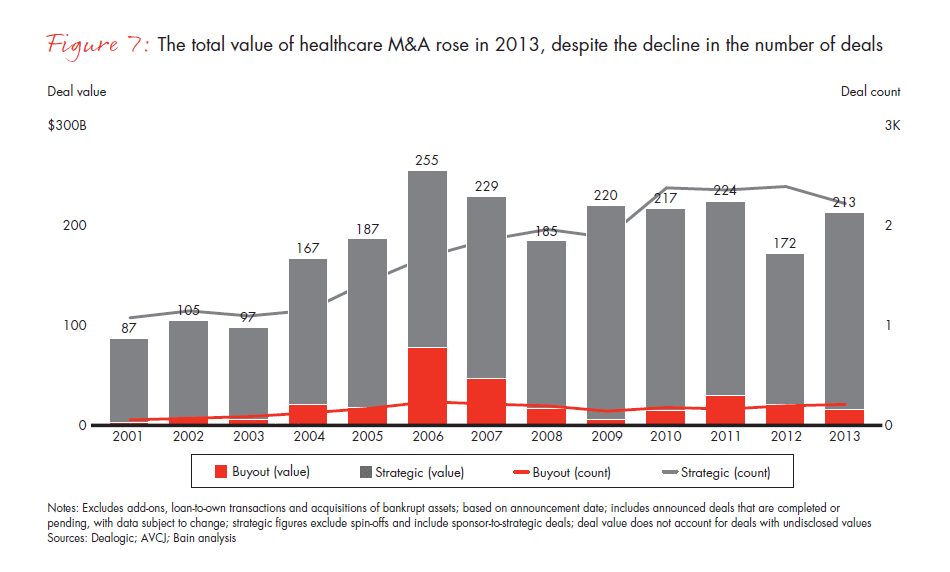
Large public healthcare companies also made a number of significant divestitures in 2013. Few were in need of cash; instead, most are increasingly stripping away noncore assets so management can focus on the core business and high-growth markets. There were three very large spin-offs: Abbott Laboratories’ AbbVie (pharma), Pfizer’s Zoetis (animal health) and Covidien’s Mallinckrodt (pharma). While AbbVie and Zoetis were never in play for private equity due to their large size, many divestitures created buying opportunities for private equity sponsors, a number of which have been previously discussed in this report. In a different year, Covidien’s Mallinckrodt might have gone to private equity investors rather than the public equity market.
On the acquisition side, strategic players continued to look for opportunities within several longstanding themes. In pharma, finding new sources of innovation while accepting pipeline risk was one prominent theme, as illustrated by AstraZeneca’s more than $1 billion acquisition of Pearl Therapeutics, a firm focused on preventing and treating common respiratory diseases. Geographically, mature markets remained of interest because of their higher spending per patient, despite cost-containment pressures and other headwinds against healthcare spending in them. Along those lines, Amgen acquired US-based Onyx Pharmaceuticals in the oncology space for $10 billion. At the same time, large healthcare companies are increasingly looking to expand into emerging markets. Though the per-patient spending is much lower in those geographies, higher expected growth rates and a relatively small degree of competition make them very attractive. For example, US-based Stryker acquired orthopedic manufacturer Trauson for $764 million in order to increase its presence in China and expand into the value segment of the emerging markets.
In the provider space in particular, strategic players in developed markets continued to consolidate. In the US, hospital group Community Health Systems spent $7.6 billion to acquire Health Management Associates and Tenet Healthcare bought Vanguard Health Systems for more than $4 billion. There was also significant noncash M&A activity among not-for-profit hospitals, as well as the formation of countless partnerships. For example, the Mayo Clinic Care Network continued to expand its membership across the country and added its first international member in Mexico. Physician organizations rolled up significant numbers of provider practices during the year. In Europe, Fresenius SE acquired 43 hospitals in Germany for $4 billion.
Strategic involvement in the medtech sector was strong. The largest deal of the year was Thermo Fisher’s previously discussed acquisition of Life Technologies. Another notable deal was Stryker’s $1.65 billion acquisition of Mako Surgical to expand its capabilities in robotic-assisted surgery. This deal shows that strategic buyers aren’t immune to the steep valuations facing private equity investors. Stryker paid an 86% premium to Mako’s share price and 10 times the not-yet-profitable company’s 2014 projected revenue—and its share price climbed in the weeks following the announcement, suggesting investor support for the long-term value of this aggressive strategic move. All in all, with a total medtech deal value of approximately $52 billion, strategic buyers clearly dwarfed the approximately $2 billion worth of deals that private equity firms saw in this sector last year.
Strategic buyers should not simply be looked at as competition for, or sources of, assets, however. Some private equity firms are now partnering with strategic buyers to bid for assets, in an effort to get an edge over other bidders. For example, Blackstone paired up with industrial conglomerate Danaher Corporation twice in 2013, first to bid on J&J’s OCD unit and later to bid on the water technologies unit of chemical manufacturer Ashland.
Exit activity
Section highlights
- Record year for exit volume
- Strategic buyers were very active
- IPO exits jumped in number
- Exit overhang persisted
Exit activity in 2013 for healthcare buyouts reached a high for the decade, jumping 34% compared with 2012 to reach 133 transactions (see Figure 8). Activity spanned all exit channels, including 70 exits to strategic buyers, up from 66 in 2012, and 32 exits to sponsors, up from 25 in 2012 (see Figure 9). Most dramatically, there were 31 exits via IPOs in 2013, up from 8 in 2012, a statistic that reflects the strength of the equity markets, especially in the US. Although investors who exit through an IPO typically need years to realize the full value of their investment, this activity is a key step to monetize their investments.
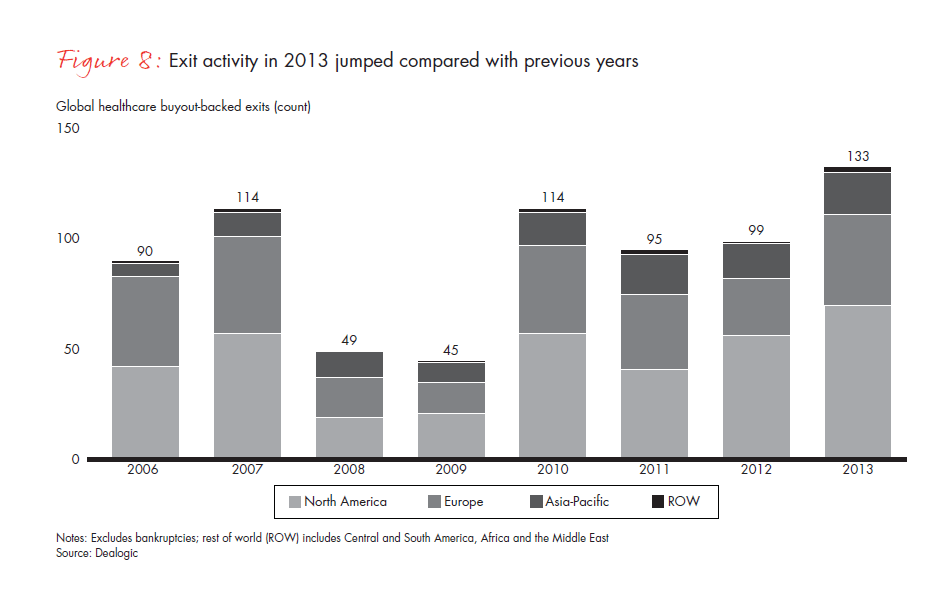
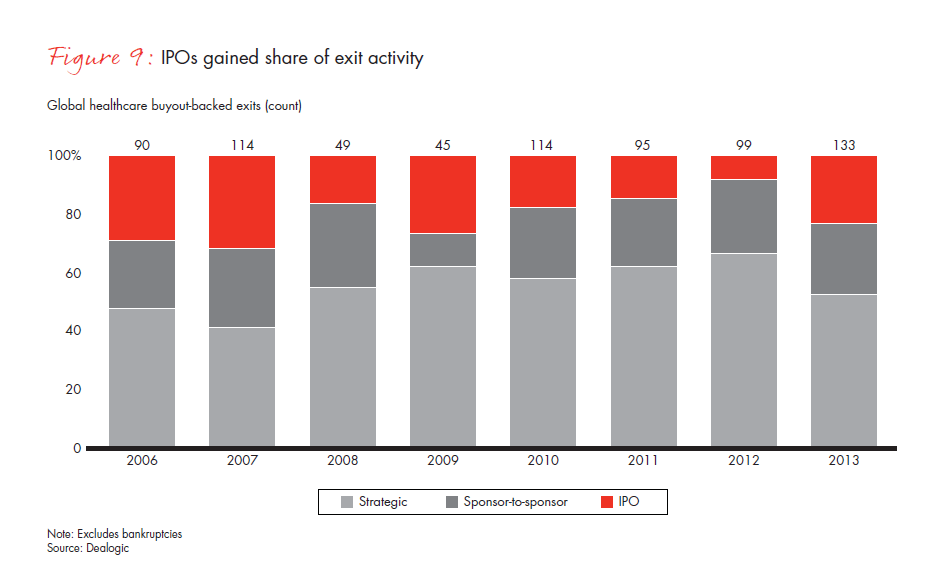
The two largest private equity-backed healthcare IPOs of the year were Quintiles Transnational Holdings and Envision Healthcare. Quintiles, the world’s largest CRO, sold 20% more shares than expected and raised $947 million. Company directors sold shares, as did investors Bain Capital, TPG Capital, 3i Group and Temasek Holdings, all of which retained ownership stakes in the company. Envision Healthcare (formerly Emergency Medical Services), the largest US provider of ambulance services, raised $966 million via IPO; owner CD&R did not float any shares and retained a majority stake in the company.
Several of the year’s largest buyouts represent sponsor-to-sponsor exits: Odyssey Investment Partners exited OCCM with its sale to Apax; Oak Investment Partners and Baird Capital exited their investments in PharMEDium with its sale to CD&R; and Genstar Capital reportedly profited $500 million on its sale of PRA International to KKR, after taking into account debt payments and dividends.
As the numbers indicate, strategic buyers continued to be an important channel for exit activity. The 70 purchases they made in 2013 amounted to more than $22 billion, with investments spanning all sectors. In the largest exit of the year, Valeant Pharmaceuticals acquired Bausch + Lomb for nearly $9 billion from a group of investors led by Warburg Pincus. When Tenet Healthcare acquired Vanguard Health Systems for more than $4 billion, part of that money ($617 million) went to the company’s largest shareholder, Blackstone Group. CD&R and GS Capital exited home health distributor AssuraMed via the more than $2 billion purchase by Cardinal Health, less than three years after investing in the asset.
Despite the strong exit activity in 2013, the exit overhang of healthcare investments remaining from the boom years remains large. Bain analysis finds that, as of December 2013, 30% of assets in healthcare buyouts announced in 2006, 40% of 2007 assets and 50% of 2008 assets are still held by the buyer (see Figure 10). While in some cases, these are strong performers that private equity firms have chosen to hold for an extended period of time, many of them have suffered from a combination of unfavorable competitive dynamics coupled with unforeseen technology or business disruptions that significantly impacted growth, especially in the medtech sector.
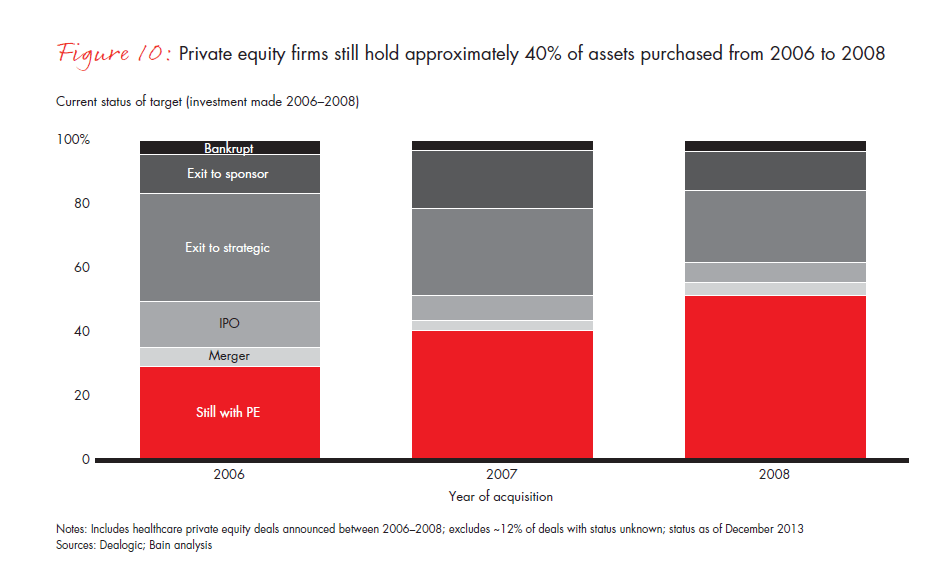
As hold times lengthen, it becomes even harder for private equity funds to achieve either their carry hurdle rate or the rates of return that LPs have come to expect for the corresponding vintage. For a deal done eight years ago, in 2006, for example, the multiple of money earned at sale needs to be in excess of 3.5 times in order to achieve a 15% net IRR (assuming a 2% management fee, 20% carry and no dividend payouts), compared with only about 2.5 times for an asset held for five years. As discussed in “Portfolio value creation is a key element of successful exits,” below, portfolio value-creation activities are a critical component of many successful exits; in the case of extended hold times, they can be especially critical.
Portfolio value creation is a key element of successful exits
Market conditions weren’t the only reason that 2013 saw such strong exit activity. In many cases, funds invested in assets at relatively high valuations, but they had clear plans from the beginning to aggressively manage the business to create top-tier returns. Our experience suggests that many of the funds with top exits in 2013 were actively involved with their portfolio companies—working on strategic positioning, exit strategy, and investment and exit horizon levers—to generate these returns. This active approach put assets in the best position to capitalize on the exit opportunities that emerged during the year.
Take Warburg Pincus and JHP Pharmaceuticals, for example. Warburg bought the parent company of JHP Pharmaceuticals, which specializes in sterile injectable products, in late 2012 from Morgan Stanley Principal Investments for $195 million. Under Warburg’s ownership, the company expanded its manufacturing capacity and more than doubled its pipeline, from 13 to 30 products. In early 2014, Warburg agreed to sell the company to TPG Capital-backed Par Pharmaceutical for $490 million, earning an excellent return.
The growing importance of having a clear plan for creating value in portfolio companies from the outset was reflected in the Healthcare Private Equity Association’s survey. Respondents believe funds need to focus more closely on post-close activities: 43% reported spending more effort to achieve deal theses in 2013 than in the previous two years and 51% expect to be very highly involved at the board level of their portfolio companies. Respondents considered geographic expansion, operating changes and a significant number of add-on acquisitions to be the most critical levers to achieving their deal theses. But interestingly, the perceived impact of these activities varied by sector. More than 60% of respondents agreed that post-close activities have high or extremely high impact on creating value in the provider, medtech and services sectors, while responses were mixed for other sectors.
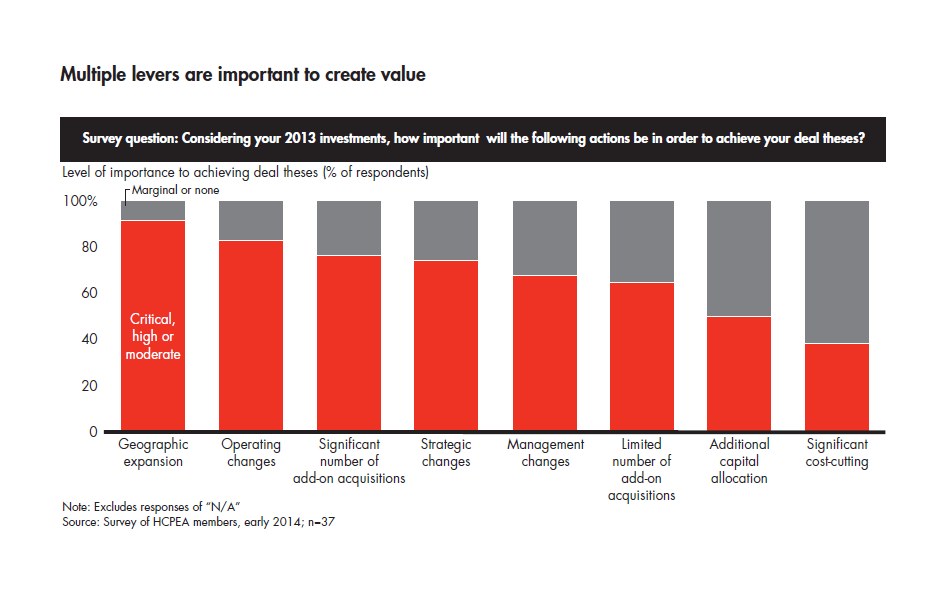
2014 and beyond
Section highlights
- Smaller deal sizes will remain a part of the new normal
- Corporate carve-outs should continue to fuel larger deals
- Value creation increasingly hinges on greater degrees of expertise and post-close attention from investors
- More firms are refining their sweet spot
- Two camps of investors are emerging; both with potential winners
Looking at the year ahead, we see the trend of smaller deals persisting. In particular, we expect private equity firms to stay active in deals involving earlier-stage assets. The most successful funds will bring specialized skill sets to these investments to add outsized value, from capital-raising to relationships with operating advisors who have track records of success in the industry to M&A know-how. The acceleration of corporate carve-outs will help fuel the pipeline for larger deals, thanks to rich valuations and pressure from investors that prompts strategic players to sell off noncore assets.
Healthcare investment opportunities should continue to expand across a variety of dimensions. Globally, new technologies in the HCIT space (and potentially in the clinical space) will create one pocket of new assets of interest to both private equity and venture capital. In the US, persistent pressures to contain costs and improve quality will keep driving the development of new payment models (e.g., ACOs), proliferation of care models (e.g., medical homes) and new customer segments (e.g., individuals on private exchanges, newly eligible Medicaid enrollees and so on). That should provide investors with opportunities to get involved in emerging niches such as ACO services firms and private exchanges. These trends will also generate more opportunities for value creation and consolidation within the provider landscape, which could prompt activity involving physician groups and, potentially, hospitals. Finally, growth in economies, populations and chronic disease incidences in emerging markets means that the subset of investors who have built capabilities in those regions will be able to further capitalize on them.
Corporate carve-outs will also continue to provide opportunities for healthcare private equity investors. As attractive as these carve-outs may be from a size perspective, however, they are exceptionally demanding for investors. For one, they typically occur in mature, slow-growth markets, so buyers need deep industry expertise in order to price the asset during the bidding process and to maximize value post-close. These assets have rarely been the focus of management’s attention and have room for improvement in a number of areas, so success often requires a multiyear transformation journey. Buyers also need to excel at “standing up” a company, efficiently setting up back-office functions to avoid any operational hiccups when the asset detaches from the strategic seller. Notably, while many of the carve-outs to date have involved product-based assets, we may see the trend expand to service-based assets in the coming years, which will require further evolution in the buyer skill set.
In the wake of these new market opportunities and the changing healthcare private equity landscape, funds will need to reassess their strategies. Many of these strategy choices involve multiyear trends and difficult decisions, particularly on the part of mega-funds, and the results of these choices will influence the industry for years to come.
For now, we’re starting to see early signs of a separation of funds into two very distinct camps. In one, private equity firms are interested in healthcare largely as a way to create some diversity in their portfolios. This type of investor focuses on getting easier-to-manage large prize assets that are likely insulated from reimbursement, regulatory or technology risks―and will pay a higher price that makes it hard to generate outsized returns. In the other camp, investors come with deep healthcare expertise and are willing to pursue contrarian or earlier-stage assets. These deals may be messier and in more-complex healthcare-heavy segments, but could potentially offer greater return upside. There can be winners in either of these camps, but if this separation continues to play out, funds that aren’t clear about their chosen strategy might get stuck in the middle—unwilling to pay steep prices for prize assets but also unable to extract the value required for contrarian and earlier-stage assets.
Once a fund has assessed its overall strategy, defining a deal sweet spot helps keep focus on its differentiated strengths. Funds that have a well-defined deal sweet spot see many benefits, including better clarity around which opportunities deal teams should pursue, sharper due diligence (as the deal teams are aware of common investment themes and core issues to test in every deal candidate) and increased investment committee effectiveness thanks to pattern recognition across deals. But getting the sweet spot right is not a trivial exercise. Too narrow a sweet spot can lead to a shortage of investment opportunities; too broad a sweet spot or lack of clarity can lead to bad investment decisions and organizational issues.
From Bain’s strategy work with private equity funds, we have seen the following six dimensions becoming especially important for healthcare investors to consider when defining their deal sweet spot:
- Ideal equity check size and tolerance for smaller deals
- Tolerance for value vs. growth assets
- Tolerance for reimbursement risk and associated preference for healthcare heavy or healthcare light assets
- Preference for healthcare product vs. services assets
- Required degree of portfolio company activism to achieve target returns
- Geographic mix
Determining a fund’s preference across each of these dimensions goes a long way to informing investment decisions and increasing efficiency.
Regardless of which fund strategy and sweet spot a private equity fund pursues, it is clear that post-acquisition value creation will be an essential ingredient in the recipe for outsized returns. Asset prices are high and market beta going forward will be limited, as GDP growth will be modest. Private equity funds will see little benefit from multiple expansion and leverage is pushing up asset prices rather than allowing buyers to profit by carrying higher levels of debt. To generate the returns that institutional investors have come to expect from private equity, funds will have to flex their alpha-generating muscles to increase the value of the assets they acquire.
We are optimistic the healthcare industry will continue to offer attractive investment opportunities—but it won’t be easy. Industry trends are challenging historical levers for growth, and competition is clearly intensifying. On the positive side, there is a growing need for healthcare services because of population growth and an increasing prevalence of diseases. On the downside, the pressure to contain costs will keep expanding and put pressure on historically high-growth segments. Strategic players will continue to play the dual role of friend and foe—generating a pipeline of assets via carve-outs and a channel for exits, but at the same time driving competition for assets and higher prices. The traditional rules that steered investors into high-growth, high-return areas no longer apply. Instead, funds will either have to pay up for growth or find creative approaches to extract value from their assets.








